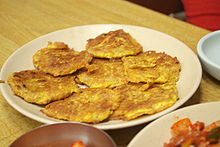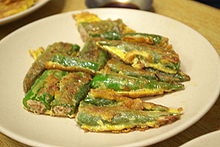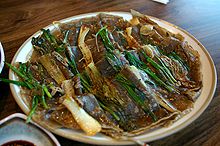- Jeon (food)
-
Jeon 
Pajeon, a variety of jeon mainly made with green onionOrigin Alternative name(s) jun, chon, buchimgae, jijimgae, jijim Place of origin Korea Region or state Korean-speaking areas Dish details Course served Appetizer, banchan (side dish), anju Main ingredient(s) sliced meats, poultry, seafood, and vegetables, flour batter or egg batter Jeon Hangul 전, 전유어, 전유화, 저냐, 부침개, 지짐, 지짐개 Hanja 煎, 煎油魚, 煎油花, none, none, none, none Revised Romanization jeon, jeonyueo, jeonyuhwa, jeonya, buchimgae, jijim, jijimgae McCune–Reischauer chŏn, chŏnyuŏ, chŏnyuhwa, chŏnya, puch'imgae, chijim, chijimgae Jeon (also spelled jun or chon), buchimgae, jijimgae, or jijim refer to many pancake-like dishes in Korean cuisine. It has been also called jeonyueo or jeonyuhwa, especially in Korean royal court cuisine. Sometimes, jeonya (hangul: 저냐) is used as an abbreviated term for the two. Jeon is made with various ingredients such as sliced meats, poultry, seafood, and vegetables depending on the style and mixed with flour batter or coated with egg batter and then pan-fried with oil.
Jeon is commonly eaten as an appetizer, as banchan (small side dishes), or as anju (food to eat while drinking). Jeon is also served as an important food for jesasang (제사상, 祭祀床, ceremonial table setting for jesa, ancestor worship) and janchi (hangul: 잔치, feast, or festival). The jeon used for jesa is called gannap (hangul: 간납, hanja: 干納 or 肝納) or gannam (hangul: 간남, hanja: 肝南) which is made with beef liver, omasum, or fish along with vegetables and green onions on a skewer.[1]
Jeon are sometimes eaten as a sweet dessert; one such variety is called hwajeon (literally "flower jeon"). Bindaetteok (mung bean pancake), pajeon (green onion pancake), and kimchijeon are popular jeon in South Korea. The jeon name commonly follows its main ingredient.
Contents
Types
Meat
- Yukjeon (육전 肉煎), made with shredded beef
- Wanjajeon (완자전) or wanja (완자), small ball-shaped jeon comprising minced beef, tofu, and vegetables, coated with wheat flour and egg batter
- Ganjeon (간전), made with beef liver
- Cheonyeopjeon (처녑전), made with omasum
Seafood
Saengseonjeon (생선전 生鮮煎) is a generic term referring to any jeon made with fish. Generally, white fish is preferred for making jeon. Whereas haemul jeon (해물전 海物煎) includes jeon made with not only fish but also paeryu (패류 shellfish), shrimp and octopus.
- Mineojeon (민어전 民魚煎), made with croaker
- Daegujeon (대구전 大口煎), made with Pacific cod
- Guljeon (굴전), made with oysters
- Daehajeon (대하전 大蝦煎), made with fleshy prawn
- Saewoojeon (새우전), made with shrimp
Vegetables and mushrooms
- Kimchijeon (김치전), made with kimchi
- Pajeon (파전), made with green onions
- Gamjajeon (감자전), made with grated potato
- Hobakjeon (호박전), made with squash
- Yeongeunjeon (연근전), made with lotus root
- Gochujeon (고추전), made with chili peppers
- Gajijeon (가지전), made with eggplant
- Deodeokjeon (더덕전), made with deodeok (Codonopsis lanceolata)
- Gosarijeon (고사리전), made with bracken
- Pyogojeon (표고전), made with shiitake mushrooms and beef[2]
Others
- Bindaetteok (빈대떡), made with mung beans, various vegetables, and meat or seafood
- Memiljeon (메밀전), made with buckwheat
- Dubujeon (두부전), made with tofu
- Hwajeon (화전), made with edible flowers, such as azalea or rose
See also
References
- ^ Yoon, Seoseok (윤서석) (1991). "간납 [Jeonbuk Food Culture Plaza, Korean cuisine terms]" (in Korean). Mineumsa. http://www.jbfood.go.kr/juhtml/food/tword/main.html?thid=1249&fpmode=view&plcode=000200050000.
- ^ Chung, Soon Yung (2001). Korean Home Cooking. Tuttle Publishing. p. 65p. ISBN 0794650066. http://books.google.com/books?id=jj4LHO4QmMgC&pg=PA65&lpg=PA66&dq=kimchi+fried+rice&as_brr=3&client=firefox-a&sig=cRWW5-oh7ZDcHF1KCtw7HrQnSSg. Retrieved 2008-04-02.
- Amy Chae. "정월초하루, 설날음식 소개" (in Korean). wa21.co.kr. http://www.wa21.co.kr/board/?doc=bbs/gnuboard.php&bo_table=cooking&page=1&wr_id=192. Retrieved 2008-02-19.
- "Korean Food Culture Series - Part 1, Korean Food". Korean Tourism Organization. http://english.tour2korea.com/03Sightseeing/TravelSpot/travelspot_read.asp?oid=2339&kosm=m3_8. Retrieved 2008-02-19.
- "Jeon (전 煎)" (in Korean). Empas/ EncyKorea. http://100.empas.com/dicsearch/pentry.html?s=K&i=249423&v=44. Retrieved 2008-02-19.
Jeon Pancakes Types Æbleskiver • Appam • Bánh cuốn • Bánh xèo • Bannock • Blintz • Boûkète • Boxty • Cachapa • Chalboribbang • Chapati • Chataamari • Chinese pancake • Crempog • Crêpe • Dosa • Dutch baby pancake • Eggette • Farinata • Flädle • Fläskpannkaka • Funkaso • Galette • Hirayachi • Hortobágyi palacsinta • Injera • Jeon • Jonnycake • Khanom bueang • Memela • Memiljeon • Mofletta • Murtabak • Nalesniki • Oatcake • Okonomiyaki • Palatschinke • Pannekoek • Pathiri • Pesarattu • Ploye • Poffertjes • Potato pancake • Quarkkäulchen • Rava dosa • Roti prata • Sel roti • Socca • Spring pancake • Suncake • Serabi • Thalipeeth • Tlacoyo • Touton • UttapamBrands  Book:Crêpes, pancakes, and waffles ·
Book:Crêpes, pancakes, and waffles ·  Category:Pancakes ·
Category:Pancakes ·  Portal:Food
Portal:Food
This article is part of a series on Korean cuisine
한국 요리AncillariesBeveragesOtherKimchi Field Museum • Kimchi refrigerator • List of Korean dishes • List of Korean beverages • Korean royal court cuisine Korea portalCategories:
Korea portalCategories:
Wikimedia Foundation. 2010.



